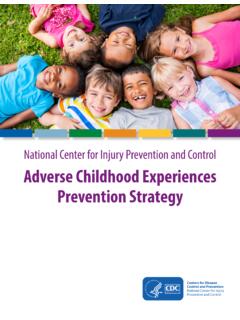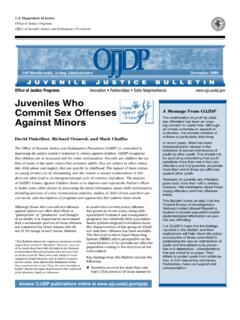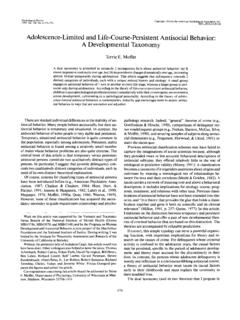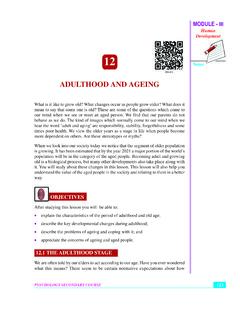Transcription of Preventing Bullying
1 2 020 What is Bullying ? Bullying is a form of youth violence and an adverse childhood experience (ACE). CDC defines Bullying as any unwanted aggressive behavior(s) by another youth or group of youths, who are not siblings or current dating partners that involves an observed or perceived power imbalance and is repeated multiple times or is highly likely to be repeated. Bullying may inflict harm or distress on the targeted youth including physical, psychological, social, or educational Common types of Bullying include: Physical such as hitting, kicking, and tripping Verbal including name calling and teasing Relational/social such as spreading rumors and leaving out of the group Damage to property of the victimBullying can also occur through technology, which is called electronic Bullying or A young person can be a perpetrator, a victim, or both (also known as bully/victim ).
2 How big is the problem? Bullying is widespread in the United States. Bullying negatively impacts all youth involved including those who are bullied, those who bully others, and those who witness Bullying known as bystanders. Bullying is common. About 1 in 5 high school students reported being bullied on school property, and more than 1 in 6 high school students reported being bullied electronically in the last Some youth experience Bullying more than others. Nearly 40% of high school students who identify as lesbian, gay, or bisexual and about 33% of those who were not sure of their sexual identity experienced Bullying at school or electronically in the last year, compared to 22% of heterosexual high school students. About 30% of female high school students experienced Bullying at school or electronically in the last year, compared to about 19% of males.
3 Nearly 29% of White high school students experienced Bullying at school or electronically in the last year compared to about 19% of Hispanic and 18% of Black high school Bullying is a frequent discipline problem. Nearly 14% of public schools report that Bullying is a discipline problem occurring daily or at least once a week. Reports of Bullying are highest in middle schools (28%) followed by high schools (16%), combined schools (12%), and primary schools (9%). Reports of cyberbullying are highest in middle schools (33%) followed by high schools (30%), combined schools (20%) and primary schools (5%).3 Preventing Bullying high school students reported being bullied at school in the last in 5 More than high school students reported being cyberbullied in the last in 6!
4 !!!!!!!!!National Center for Injury Prevention and Control Division of Violence Prevention What are the consequences? Bullying can result in physical injury, social and emotional distress, self-harm, and even death. It also increases the risk for depression, anxiety, sleep difficulties, lower academic achievement, and dropping out of school. Youth who bully others are at increased risk for substance misuse, academic problems, and experiencing violence later in adolescence and Youth who bully others and are bullied themselves suffer the most serious consequences and are at greater risk for mental health and behavioral can we stop Bullying before it starts?The good news is that Bullying is preventable. CDC s A Comprehensive Technical Package for the Prevention of Youth Violence and Associated Risk Behaviors helps communities and states prioritize youth violence prevention strategies based on the best available The strategies and approaches in the technical package are intended to impact individual behaviors as well as the relationship, family, school, community, and societal factors that influence risk and protective factors for violence.
5 The strategies are meant to work together and be used in combination to prevent violence. These approaches, particularly universal school-based programs that strengthen youths skills and modify the physical and social environment, have been shown to reduce violence and Bullying . Promote family environments that support healthy development Early childhood home visitation Parenting skill and family relationship programs Provide quality education early in life Preschool enrichment with family engagementStrengthen youth s skills Universal school-based programsConnect youth to caring adults and activities Mentoring programs After-school programsCreate protective community environments Modify the physical and social environment Reduce exposure to community-level risks Street outreach and community norm changeIntervene to lessen harms and prevent future risk Treatment to lessen the harms of violence exposures Treatment to prevent problem behavior and further involvement in violence Hospital-community partnerships A Comprehensive Technical
6 Package for the Prevention of Youth Violence and Associated Risk BehaviorsA technical package is a collection of strategies based on the best available evidence to prevent or reduce public health problems. The strategy lays out the direction and actions to prevent youth violence. The approach includes the specific ways to advance the strategy through programs, policies and practices. The evidence for each of the approaches in Preventing youth violence and associated risk factors is also Gladden RM, Vivolo-Kantor AM, Hamburger ME, Lumpkin CD. Bullying surveillance among youths: Uniform definitions for public health and recommended data elements, Version Atlanta, GA; National Center for Injury Prevention and Control, Centers for Disease Control and Prevention and Department of Education; 2013.
7 Available from Centers for Disease Control and Prevention. Youth risk behavior surveillance United States, 2019. Morbidity and Mortality Weekly Report--Surveillance Summaries 2020; 69(SS1). Available from Diliberti, M., Jackson, M., Correa, S., and Padgett, Z. (2019). Crime, Violence, Discipline, and Safety in Public Schools: Findings From the School Survey on Crime and Safety: 2017 18 (NCES 2019-061). Department of Education. Washington, DC: National Center for Education Statistics. Retrieved from Farrington D, Baldry A. Individual risk factors for school Bullying . Journal of Aggression, Conflict and Peace Research 2010; 2(1):4-16. Available from David-Ferdon C, Vivolo-Kantor AM, Dahlberg LL, Marshall KJ, Rainford N, Hall JE. A Comprehensive Technical Package for the Prevention of Youth Violence and Associated Risk Behaviors.
8 Atlanta, GA: National Center for Injury Prevention and Control, Centers for Disease Control and Prevention, 2016. Available from (232-4636)



















